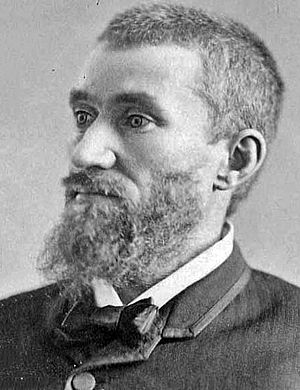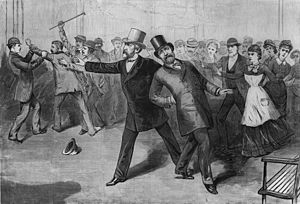Charles J. Guiteau facts for kids
Quick facts for kids
Charles J. Guiteau
|
|
|---|---|

Guiteau in 1881
|
|
| Born |
Charles Julius Guiteau
September 8, 1841 Freeport, Illinois, U.S.
|
| Died | June 30, 1882 (aged 40) D.C. Jail, Washington, D.C., U.S.
|
| Cause of death | Execution by hanging |
| Known for | Assassination of James A. Garfield |
| Political party |
|
| Spouse(s) |
Annie Bunn
(m. 1869; div. 1874) |
| Motive | Mental illness, schizophrenia and/or grandiose narcissism; retribution for perceived failure to reward campaign support |
| Conviction(s) | Murder |
| Criminal penalty | Death |
| Details | |
| Victims | James Abram Garfield, aged 49 |
| Date | July 2, 1881 |
| Location(s) | Washington, D.C., U.S. |
| Signature | |
 |
|
Charles Julius Guiteau (pronounced gih-TOH; born September 8, 1841, died June 30, 1882) was an American who shot and killed James A. Garfield, the President of the United States, in 1881. Guiteau wrongly believed he had helped Garfield win the election and felt he should have been rewarded with an important job, like a consul (a government official who represents their country in another city). He became very upset when his requests for jobs in Vienna or Paris were turned down. Because of this, he decided to kill President Garfield. He shot Garfield at a train station in Washington, D.C. President Garfield died two months later from infections related to his wounds. In January 1882, Guiteau was sentenced to death for the crime and was executed five months later.
Contents
Charles Guiteau's Early Life
Charles J. Guiteau was born in Freeport, Illinois. He was the fourth of six children. His mother passed away in 1848. In 1850, his family moved to Ulao, Wisconsin, where he lived for five years before moving back to Freeport with his father.
In 1860, Guiteau received $1,000 from his grandfather. He planned to attend the University of Michigan but did not pass the entrance exams. He then studied French and algebra at Ann Arbor High School. During this time, his father encouraged him to join the Oneida Community, a religious group in Oneida, New York. Guiteau left school and joined the community in June 1860. He greatly admired the group's founder, John Humphrey Noyes.
Guiteau stayed with the Oneida Community for five years, but he often felt left out. He tried to start a newspaper based on the community's ideas, but it failed. He left the community twice and even tried to sue Noyes. His own father thought Guiteau was irresponsible.
Guiteau's Career and Political Interests
Guiteau worked as a clerk at a law firm in Chicago and later became a lawyer. However, he was not very successful. He only argued one case in court, and his client was found guilty. Most of his work involved collecting money for others. In 1869, he married Annie Bunn.
In 1872, Guiteau and his wife moved to New York City. He became interested in politics and supported the Democratic Party. In the 1872 presidential election, he supported Horace Greeley. Guiteau gave a speech for Greeley and believed that if Greeley won, he would be made an ambassador to Chile. However, Greeley lost the election.
Guiteau then turned back to religion. He published a book called The Truth, but much of it was copied from John Humphrey Noyes's work. By 1875, Guiteau's father thought his son was acting strangely. Guiteau, however, became more and more convinced that God was guiding his actions. He believed he was meant to "preach a new Gospel." He traveled around giving lectures.
In 1880, Guiteau was a passenger on a ship that crashed in heavy fog. He was not hurt, and he believed he had been saved for a special purpose.
Guiteau's attention then returned to politics. During the 1880 presidential election, the Republican Party was divided. Guiteau decided to support the "Stalwarts," a group within the party. He wrote a speech supporting Ulysses S. Grant, but when James A. Garfield won the Republican nomination, Guiteau simply changed the name in his speech to Garfield. He gave this speech only a couple of times and handed out copies. Even so, Guiteau believed he was largely responsible for Garfield's victory. He strongly felt he deserved a job as a consul for his help, first asking for Vienna, then Paris. Guiteau visited Garfield and his cabinet many times, asking for a job, but his requests were always turned down.
By March 1881, Guiteau was living in Washington, D.C., and had no money. He often sneaked out of boarding houses without paying for his room or food. He spent his days in hotel lobbies, reading old newspapers to find out where Garfield and his cabinet would be. He used the hotels' free paper to write letters, still asking for a consul job. In May 1881, he met James G. Blaine, the Secretary of State, and asked about a job again. Blaine finally told him, "Never speak to me again on the Paris consulship as long as you live!"

The Shooting of President Garfield
Guiteau thought of himself as a loyal Republican and a "Stalwart." He was convinced that his work had been very important for Garfield's election. After his last meeting with Blaine, he decided that the only way to fix things was to remove Garfield from office. He believed this would make Vice President Chester A. Arthur president, who was friends with the Stalwart leader.
One day, Guiteau followed President Garfield to a train station. Garfield was seeing his wife off on a trip. Guiteau decided not to shoot him that day because Garfield's wife was not well, and he did not want to upset her.
On July 2, 1881, Guiteau waited for Garfield at the train station. He had his shoes shined and hired a cab to take him away later. As Garfield entered the station, excited for a vacation, Guiteau stepped forward and shot him. As he was arrested, Guiteau shouted, "I am a Stalwart of the Stalwarts. ... Arthur is president now!"
President Garfield's Death
After being shot, President Garfield suffered for 11 weeks with infections. He passed away on September 19. Doctors today believe that Garfield would have easily recovered from his wounds if he had received modern, clean medical care, which was not common back then. Some also suggest that starvation played a role in his death.
Guiteau's Trial and Execution
Once President Garfield died, the government officially charged Guiteau with murder. His trial began on November 17, 1881, in Washington, D.C. Guiteau insisted on trying to defend himself, but the court appointed lawyers to help him.
Guiteau's trial was one of the first important cases in the United States where a defense based on "temporary insanity" was used. Guiteau strongly argued that he was legally insane when he shot Garfield because he believed God had told him to do it. However, he also claimed he wasn't "medically" insane.
During the trial, Guiteau behaved very strangely. He often cursed and insulted the judge, witnesses, and even his own lawyers. He would recite his testimony as long poems. He also tried to get legal advice from people watching the trial. He even wrote his life story for a newspaper and placed a personal ad looking for a "nice Christian lady." He seemed unaware that the public hated him, and he often smiled and waved at reporters.
Guiteau wrote a letter saying that President Arthur should free him because he had made Arthur president. He also argued that Garfield had died because of poor medical care, not from the bullet. Guiteau was held at St. Elizabeths Hospital while awaiting trial and execution. He even wrote a book defending his actions.
Until the very end, Guiteau planned to go on a lecture tour after he thought he would be released. He even wanted to run for president in 1884. He was found guilty on January 25, 1882, and sentenced to death. His appeal was rejected.
Twenty-nine days before his execution, Guiteau wrote a long poem. In it, he claimed God had ordered him to kill Garfield to stop a war. He also believed President Arthur knew the assassination had saved the country and that Arthur was being ungrateful by not pardoning him.
Charles Guiteau was executed by hanging on June 30, 1882, in Washington, D.C. This was just two days before the first anniversary of the shooting. He lived nine months and eleven days longer than his victim, President Garfield.
See also
 In Spanish: Charles J. Guiteau para niños
In Spanish: Charles J. Guiteau para niños
- List of assassins
- List of people who died by hanging
- Patronage
- Stalwart (politics)
- John Wilkes Booth, assassin of President Abraham Lincoln
- Leon Czolgosz, assassin of President William McKinley
- Lee Harvey Oswald, assassin of President John F. Kennedy




